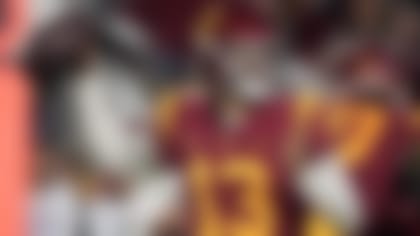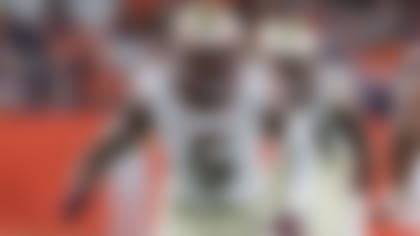Editor's note: NFL.com analyst and former NFL scout Bucky Brooks shares some of his college scouting notes, including:
» A look at the trickle-down effect of big NFL WRs on CFB prospects.
» The defensive player who could emerge as CFB's top prospect.
But first, Brooks' take on the next wave of QBs in the college pipeline, which has generated plenty of buzz over the last few months.
* * *
During the run up to the 2017 NFL Draft, I heard several of my colleagues suggest that teams in need of a franchise quarterback should consider bypassing the top prospects in a "weak" quarterback class this year and focus on landing one of the crown jewels from a so-called "loaded" 2018 quarterback class.
While I thought such conversation dismissed the talent and potential of the likes of Mitchell Trubisky, Deshaun Watson, Patrick Mahomes and others at the position, I had heard so much about the next wave at the position that I couldn't wait to take a peek at the group when the draft concluded.
In fact, I was so excited about evaluating the next generation of field generals that I popped in some tape over the weekend to get a feel for this collection of quarterbacks that I had heard so much about throughout the offseason. After spending the weekend looking at the top prospects at the position, I would tell anyone within earshot to pump the brakes on the hype train that's making this collection of quarterbacks out to be game-changers at the position.
Now, that's not a complete dismissal of the long-term potential of the quarterback prospects in the upcoming class, but I believe the same questions and concerns that plagued the 2017 group can be applied to those who could be in the 2018 class. Whether it's concerns about their transition from a spread offense to a pro-style scheme or their overall experience and game-management abilities, the top prospects at the position have just as many warts on their respective games as their predecessors. There isn't a sure-fire franchise quarterback in the group and any suggestion otherwise is based on hype, not evaluation.
For instance, USC's Sam Darnold has been touted as the consensus choice as the top quarterback prospect heading into the fall. Observers have suggested that he has the best combination of size, arm talent, athleticism and intangibles that we've seen at the position in years. While the 6-foot-4, 225-pound playmaker certainly posted impressive production and flashed outstanding potential during his 10-game run last season as the team's starting quarterback, he isn't quite a polished passer who's ready to take the NFL by storm.
Sure, he compiled a strong completion rate (67.2 percent) and touchdown-to-interception ratio (31:9) last season, but he played in a catch-and-fire system similar to the schemes that were run by Trubisky and Davis Webb. The Trojans' offense features a number of quicks, screens, RPOs (run-pass options) and mesh concepts (layered crossing routes) that are staples in most spread or Air Raid systems. Thus, Darnold will need time to transition to the pro game, just like his predecessors.
He will also need to refine his footwork and fundamentals to become a more efficient passer from the pocket and show better deep-ball accuracy when he pushes the ball down the field. With Darnold showing a little recklessness with the ball, it's quite possible that his interception totals will swell during his second season as a starter (see the reports of his interceptions during spring ball).
I see why scouts are excited about Darnold's potential. He's a gritty competitor with big-game moxie and he's capable of shredding opponents as an anticipatory thrower. However, he isn't the finished product that some would have you believe. Thus, we should hold off on crowning him the NFL's next great quarterback.
The same could be said for UCLA's Josh Rosen. The 6-4, 218-pound junior is everything that coaches and scouts covet in a traditional pocket passer. Rosen can make every throw in the book with pinpoint placement and accuracy while also showing a feathery touch.
As a freshman in 2015, he wowed evaluators with his ability move defenders with his eyes before throwing receivers open between the numbers. Rosen played like a savvy veteran at the position and exhibited the qualities (arm talent, accuracy, poise and sound judgement) that most desire at the position. Yet, he enters the 2017 season with concerns about his arm strength/talent following a shoulder injury that prematurely ended his sophomore season (missed the Bruins' final six games, underwent shoulder surgery in November). In addition, scouts have concerns about his prickly personality and leadership skills based on interactions with teammates and coaches during his tenure.
Considering how medical issues and character concerns can affect final draft grades, Rosen also has a lot to prove before earning a franchise quarterback label.
Wyoming's Josh Allen has been touted as the biggest wild card of the group based on his A-plus arm talent, gunslinger mentality and experience directing a pro-style offense that produced a quality QB prospect a few years ago (see Carson Wentz).
Measuring 6-5, 222 pounds, Allen is the big, athletic quarterback that coaches and scouts salivate over during the pre-draft process. As a fastball pitcher with unlimited range and outstanding velocity, he can make tight-window throws without flinching. While some of those throws skew toward the "high-risk, high-reward" nature, the Cowboys' QB1 possesses the arm talent to pull it off in most instances. While that is certainly a positive aspect of his game, particularly in dire situations, Allen's tendency to "throw it up" without regard is also a huge concern. He tallied 15 interceptions during his first season as a starter, including seven picks during the team's final five games (1-4 record), which contributed to their late-season slide. Remember how much we discussed Watson's interception totals and Mahomes' gunslinging ways leading up to the draft this spring?
Allen also struggles with his accuracy and ball placement at times, as evidenced by his 56-percent completion rate, so the Wyoming gunslinger isn't the connect-the-dots passer that some teams prefer at the position. Although he still has time to refine his passing skills and master the management part of the game, Allen is more potential than production at this point.
With the other top prospects in college football (Washington State's Luke Falk, Oklahoma State's Mason Rudolph, Louisville's Lamar Jackson, Idaho's Matt Linehan, Pittsburgh's Max Browne and Auburn's Jarrett Stidham) also having a number of warts on their games, I think the next wave of QBs might not be the collection of crown jewels that I expected based on the hype. Let's see if that opinion changes after they take the field this fall.
* * *
Big man's game at wide receiver
Who says size doesn't matter at wide receiver?
It certainly wasn't a coach, scout or general manager based on the results of the 2017 draft. Looking back at the 32 receivers that were selected, I noticed that 23 pass-catchers (72 percent) measured 6-feet or taller and only three receivers selected came in at 5-foot-10 or shorter (Ryan Switzer: 5-8,181; Isaiah McKenzie: 5-7, 173; and Trent Taylor: 5-8, 181). With those guys designated as slot receivers/return specialists, the league is obviously trending toward bigger receivers on the perimeter.
"It's a big man's league," said an AFC personnel executive. "You always skew toward bigger players at the position because size matters on the perimeter, particularly down in the red zone or over the middle of the field. ... You want to expand the strike zone for the quarterback and make the game easier for him. Big guys can erase some of the quarterback's accuracy mistakes."
Naysayers will point out that T.Y. Hilton (5-9, 180) led the league in receiving yards and six other receivers that are 5-10 or shorter ranked among the top 25 in the category. However, the overwhelming majority of receivers that dominate the league measure at least 6-feet tall. Whether it's Julio Jones and Mike Evans overwhelming defenders with their size and physicality or Odell Beckham, Jr., or Jordy Nelson blowing past cornerbacks with their combination of speed, quickness and athleticism, the "bigs" are the WR1s that are thriving in the NFL.
With that in mind, I'm not surprised Western Michigan's Corey Davis and Clemson's Mike Williams were the first two receivers off the board this year based on their ability to win with size, strength and physicality on the outside. In a league where "bigs" are routinely viewed as the top pass-catchers, the trend undoubtedly will extend into the 2018 draft with the top prospects listed at 5-foot-11 or taller. Looking at the initial list of prospects that are touted as the blue-chip standouts at the position, I don't believe it's a coincidence that Texas A&M's Christian Kirk (5-11, 200), Alabama's Calvin Ridley (6-1, 188) Oklahoma State's James Washington (6-0, 205), SMU's Courtland Sutton (6-3, 215) and Clemson's Deon Cain (6-1, 210) fall into the "big" category.
While there aren't many super-sized pass-catchers in that group, the physical dimensions fall in line with who's succeeding in the league and scouts will pay close attention to the measurements when projecting players at the next level. Now, that doesn't mean that speed (4.50-second 40-yard dash or better), route-running ability and ball skills take a backseat to size, but the ability to expand the strike zone certainly matters when separating the top prospects in the pre-draft process.
* * *
Why a safety might be CFB's top player
I know the "top player in college football" label is typically reserved for quarterbacks, pass rushers and left tackles, but Florida State's Derwin James might make a bid for the title with his rare combination of size, speed, size and impact potential. The 6-foot-3, 211-pound safety is a game changer at a position that's growing in importance at the NFL level. In the 2017 draft, we watched 11 safeties come off the board in the first three rounds, including three in the first round with Jamal Adams headlining the group as the sixth overall pick.
Defensive coordinators are increasingly tapping into the versatile playmaking skills of hybrid defenders on the second level, and James' diverse set of skills could make him a nightmare to deal with as a pro. Whether it's his ability to float between the hashes as a deep-middle player or his nasty playmaking skills as a box-area defender or his disruptive potential as a pass rusher on blitzes, James is a new-school safety with the kind of talent that defensive coordinators crave in safeties. He's also a highly emotional leader with a knack for delivering big hits to runners and receivers. When I study James' tape, I see a unique mix of Adams and Reuben Foster.
That combination might appear a little odd based on James' position, but he demonstrates Adams' versatility and leadership skills and Foster's violence/physicality when he steps onto the field. He is one of the most active defenders I've studied at the position and his high-revving motor keeps him around the action no matter where he aligns on the field. In addition, he's a spectacular athlete with a size/speed combination that's uncommon for a "big" safety. I know this for a fact because James played on my 7-on-7 team at "The Opening Finals" in 2014, where he posted a 124 Nike rating based on his explosive output (6-foot-2, 200 pounds, 4.50 40, 35.5 vertical, 4.20 short shuttle, 41-foot power ball toss) as a high schooler. Considering how players continue to get bigger and stronger as collegians, James could be a workout warrior when scouts test him in workouts.
When I bring up James' name to scouts who've stopped at Florida State to check out the Seminoles' top prospects the past few years, I've heard the junior standout described as a "beast" or "stud" by more the one evaluator. In fact, I had a scout tell me that he might've been the "best prospect at the school" when he walked through the door as a freshman.
Given the Seminoles' track record for producing top NFL talent, it wouldn't surprise me to see James emerge as the No. 1 player in college football before it's all said and done.
Follow Bucky Brooks on Twitter @BuckyBrooks.













